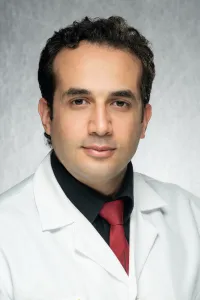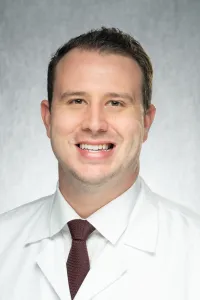Cartilage Regeneration and Repair
- For all other requests:
- 1-800-777-8442
If you have articular cartilage damage in one of your joints, you probably have persistent pain and swelling. And you may have been told there are few treatment options—especially if you’re under age 40.
That’s because articular cartilage damage is hard to treat. Repairing or restoring this type of tissue requires highly specialized surgical expertise that’s not available at every medical center.
Fortunately, you can find this expertise right here in Iowa.
Orthopedic surgeons from University of Iowa Health Care offer every procedure approved to treat articular cartilage injuries. This includes microfracture surgery, cartilage transplant procedures, and procedures to unload damaged cartilage.
These techniques are effective alternatives for some people who are too young for joint replacement surgery. They may help you stay active and functional for many years.
Understanding cartilage regeneration and repair
We can treat articular cartilage injuries in the ankle, knee, hip, shoulder, and elbow.
About articular cartilage
Healthy articular cartilage covers the ends of bones that come together to form your joints. It helps them glide smoothly (and painlessly) against each other during movement.
Although articular cartilage is durable, certain conditions and injuries can cause it to tear or break down.
When this happens, the damage is irreversible. Because articular cartilage doesn’t contain any blood vessels—which carry blood cells, oxygen, and nutrients—it can’t heal on its own.
But with the right surgery, we can help fix articular cartilage damage. Newer techniques can supplement your existing cartilage with cells grown in a lab or tissue taken from another part of your body.
Who can benefit from cartilage surgery
Not everyone is a candidate for cartilage regeneration or repair. These procedures are most effective in younger people who meet the following criteria:
-
You have chronic pain, swelling, or other symptoms in your affected joint
-
Either you don’t have any osteoarthritis in the affected joint, or it’s limited to a single, small area
If you qualify for cartilage surgery, you can have confidence in our team.
We have extensive experience performing these procedures. By keeping up with the latest developments in the field, we also offer new techniques as they become available.
Cartilage regeneration and repair techniques
UI Health Care offers several types of articular cartilage surgery. Each one offers advantages and disadvantages.
Our orthopedic surgeons are skilled at matching the right procedure to the right patient. We’ll determine which approach is best for you based on several factors. These include your age, activity level, and the extent of your cartilage damage.
During this procedure, your surgeon drills tiny holes into the bone (and bone marrow) underneath the damaged cartilage. This stimulates your bone marrow cells to produce a new type of tissue called fibrocartilage, which fills in the damaged areas.
Fibrocartilage can protect the bones in your joint the same way as articular cartilage, but it’s not as durable.
During this procedure, your surgeon removes one or more small “plugs” (pieces of tissue) from a part of your joint that doesn’t bear weight. This plug contains healthy articular cartilage and bone.
Next, your surgeon drills one or more holes within the damaged section of cartilage. Then they insert the plug(s) into the hole(s).
This process is like filling potholes in a road. It restores the smooth surface that makes articular cartilage so important to joint function.
In some cases, you may have a large area of cartilage damage—one that’s too big to plug with your own tissue. For this, your surgeon may use cartilage from a deceased donor.
This donor tissue can be trimmed so it matches the size and shape of your damaged cartilage. However, it’s not as durable as your own healthy cartilage.
This is a two-part procedure that also uses your own cartilage.
First, your surgeon removes healthy articular cartilage from a non-weight-bearing part of the joint. They send that tissue to a lab. Technicians collect special cells (chondrocytes) from your cartilage and grow more of them.
During the second procedure, your surgeon takes the new chondrocytes and implants them in your damaged cartilage. Over time, the chondrocytes create new cartilage.
This procedure is similar to ACI. The difference is that the lab grows new chondrocytes on a sheet of collagen (also known as a matrix or scaffold).
Once the matrix is ready, your surgeon glues the entire sheet into your damaged cartilage.
In this procedure, your surgeon aims to remove load from a damaged area of cartilage within the affected joint. This is performed through a procedure called an osteotomy—or bone cut—that is then fixed in a new position with plates and screws to take pressure off the damaged area of the affected joint. An osteotomy may be performed in isolation or combined with other cartilage procedures described above.
What to expect
Many people who undergo cartilage regeneration or repair achieve partial or complete relief from their symptoms. Roughly 70% to 80% of people who have one of these procedures see 70% to 80% improvement.
Here are a few other things you can expect during and after surgery:
A minimally invasive approach
In most cases, we perform cartilage surgery using a minimally invasive technique called arthroscopy (or arthroscopic surgery).
With this approach, we make a couple of small incisions around the joint. We use a tiny camera and miniature surgical tools to drill holes, remove or add tissue, or implant donor cartilage.
A lengthy recovery
Although many people return to their regular activities after cartilage surgery, that process takes time. Too much activity, or returning to activity too soon, can harm your new tissue or interfere with the healing process.
A typical recovery includes the following guidelines:
If you had surgery on your ankle, knee, or hip, you’ll need to use crutches for six to eight weeks afterward.
Depending on which joint was treated, your surgeon will help you create a plan for gradually returning to your favorite activities. For example, you may need to wait six weeks before using a stationary bike, 12 weeks to swim, and one year to jog. You may need to wait up to 18 months to resume rigorous physical activities like basketball or long-distance running.
Our Care Team


- Orthopedics and Rehabilitation

- Orthopedics and Rehabilitation


Need care for an articular cartilage injury?
Locations and Offices


